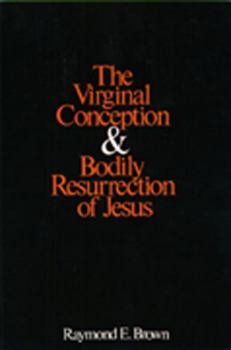The Virginal Conception and Bodily Resurrection of Jesus
Select Format
Select Condition 
Book Overview
Recent study of the Gospels has produced some surprising challenges to the historicity of the stories surrounding Jesus' birth and resurrection. There is skepticism about the star of Bethlehem, the magi, and the census, skepticism about the angels at the tomb and the manner and time of Jesus' appearances. What then about the more fundamental issues that touch on Christian faith? Was Jesus conceived without a human father? Did he rise bodily from the...
Format:Paperback
Language:English
ISBN:0809117681
ISBN13:9780809117680
Release Date:January 1972
Publisher:Paulist Press
Length:144 Pages
Weight:0.40 lbs.
Dimensions:0.4" x 5.3" x 8.0"
Related Subjects
Catholicism Christian Books & Bibles Jesus Religion Religion & Spirituality TheologyCustomer Reviews
3 ratings
Classic Raymond E Brown
Published by Thriftbooks.com User , 14 years ago
This is a classic monograph by one of the premier exegetes of the twentieth century. He applies the historical critical method to the virginal conception (sometimes inaccurately called the virgin birth) and to the bodily resurrection. Brown gives a nuanced, carefully reasoned analysis that will challenge many. If you come away pondering the truths behind these stories, Brown has succeeded.
Excellent scholarship by Raymond Brown
Published by Thriftbooks.com User , 15 years ago
Raymond Brown does his usual superb job of explaining the subject and providing Scriptural and historical support for his presentation, while clarifying misconceptions. This is highly recommended even for those who are not in doctoral programs in Religious Studies.
For a clearer understanding of Christian faith.
Published by Thriftbooks.com User , 17 years ago
Whatever the reader's convictions this book is an opportunity to reflect on two very sensitive topics for Christian faith. The author tackles them carefully and yet constructively. The book was authorized by those who are in charge of maintaining Roman Catholic tradition and yet it opens interesting perspectives to the reader who is not necessarily always satisfied with ready-made and non-negotiable formulations of what one should believe. As usual, two well known questions are raised here about the Scriptures. There is what they say and there is what some people try to make them say in order to justify their point more forcefully. There is also the nature of the language of the Scriptures : is it literal or symbolic, or a mixture of both ? ?Regarding, the virginal conception: At the beginning there is a problem of translation. In this case a « young woman » in Hebrew was changed into a « virgin » in Greek. In itself, this could be enough to drop the matter altogether, but one should not go too fast. It is indeed interesting to consider that this error may have been inspired in order to reveal a fundamental message. This message is linked to the fact that if Man needs to be saved, it seems obvious that, for that purpose, he will need the help of someone greater than him, namely the help of God ; whether God acts directly or through a Saviour. And what the text actually means when it says that the Saviour was conceived in the womb of a « virgin » is clearly that man is not at the origin of his own salvation, because the Saviour was not born from the action of a man. This is a simple and elegant message in symbolic language, but it is also highly significant. The real difficulty arises when one continues to speak of virginity after the birth of Jesus. Such a statement lacks any reference in the gospels, has no useful implications and tends to have a reverse effect on the credibility of the virginal conception, especially if one is not allowed to separate the two notions of virginity before and after the birth of Jesus. ?Regarding, the bodily resurrection of Jesus: Here, we are faced with two contradictory and yet simultaneous messages conveyed by the litteral/symbolic language of the gospels. The first is that the person who appeared for a certain period of time to a certain number of people is actually Jesus of Nazareth who had been previously crucified. He himself tries to convey this genuinely crucial message, by showing, for example, the scars of his wounds. The second is that this risen Christ is significantly different from the crucified Jesus. He appears and disappears at will, he is not affected by the presence of walls, nor conditioned by space or time. His closest friends or disciples do not recognize him when he joins them. And when eventually they recognize him, it is no longer as Jesus, but as the Lord. Definitely, something has changed in him, and Raymond E brown tells us that there are two options which are of importance




